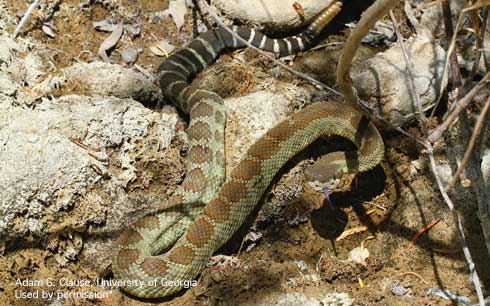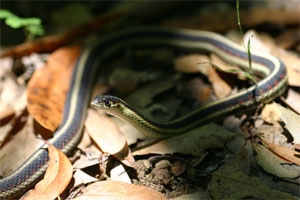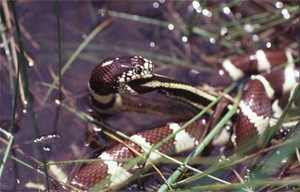Avocado orchards are prime environments for this to happen. For me, it's always startling and amazing to come across an animal that's not expected to be there, but really does belong there as much as I do. Seeing a bobcat, coyote, or deer is not necessarily as startling as seeing a mountain lion or bear. Snakes do surprise me, especially when rooting around the base of a tree looking to see if there is trunk damage. More commonly, I come across
image copyright Michael F. Benard, http://www.mister-toad.com
image copyright Michael F. Benard, http://www.mister-toad.com
The latter will eat rattlesnakes

A recent report of a sidewinder in Ojai is a reminder of the people/wildlife interactions that go on all the time in both rural and urban areas. 
Rattlesnakes do show up in coastal orchards frequently. However, it is more commonly a western rattler, not a sidewinder which is more an inhabitant of desert environments. Where did it come from? Did this snake get released into this area? Somebody's pet? Did the recent fires open it up as new habitat? Are other changes going on in the area that make it better habitat? Is this just a one off occurrence?
Whatever, sometimes people and animals get along and sometimes they don't. Remember, if left alone, a snake is likely to move on to another area. Also, recall that most rattlesnake bites occur when inexperienced people try to pick up, pester, move, or kill a rattlesnake. If you would prefer the snake be removed, it is best to call a professional pest or wildlife control operator who specializes in snake removal.
A final course of action may be to kill the rattlesnake. However, this option is not generally recommended since rattlesnakes only bite in self-defense and attempting to kill them can, and sometimes does, result in a person getting bitten. Even a dead rattlesnake can have a bite reflex and is capable of delivering venom.
Rattlesnakes are natural and important predators and automatic killing of them is not recommended any more than is the automatic killing of coyotes, mountain lions, or bears, all of which can very rarely harm people.
Guidelines from the UC IPM Rattlesnake webpage follow:
What Can be Done to Prevent a Bite?
Hands, feet, and ankles are the most common sites for rattlesnake bites. Using some common sense rules can prevent most snakebites.
- Never go barefoot or wear sandals when walking in areas where you cannot clearly see where you are placing your feet. Always wear hiking boots.
- Always stay on paths. Avoid tall grass, weeds, and heavy underbrush where snakes may be present.
- Always look for concealed snakes before picking up rocks, sticks, or firewood.
- Always check carefully around stumps or logs before sitting.
- When climbing, always look before putting your hands in a new location. Snakes can climb walls, trees, and rocks and are frequently found at high altitudes.
- Never grab what appear to be sticks or branches while swimming; rattlesnakes are excellent swimmers.
- Baby rattlesnakes are venomous! They can and do bite. Leave them alone.
- Never hike alone. Always have a buddy to help in case of an emergency. Learn basic lifesaving skills.
- Never handle freshly killed snakes. You may still be bitten.
- Never tease a snake to see how far it can strike. You can be several feet from the snake and still be within striking distance.
- Don't keep rattlesnakes as pets. Many rattlesnake bites occur when people tease or play with their “pet” rattlesnake.
- Teach children to respect snakes and to leave them alone. Curious children who pick up snakes are frequently bitten.
- Always give snakes the right of way!
http://www.californiaherps.com/movies/cccerastes611.mov
http://ipm.ucanr.edu/PMG/PESTNOTES/pn74119.html
Native Reptile Captive Propagation Laws and Regulations
https://nrm.dfg.ca.gov/FileHandler.ashx?DocumentID=35207
garter and king snake images copyright Michael F. Benard, http://www.mister-toad.com


